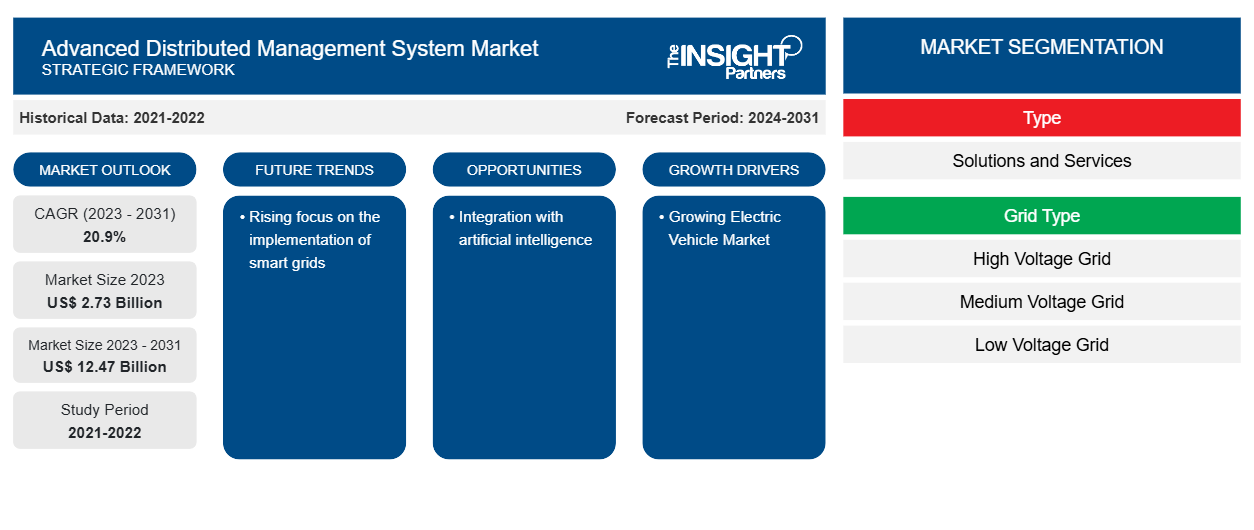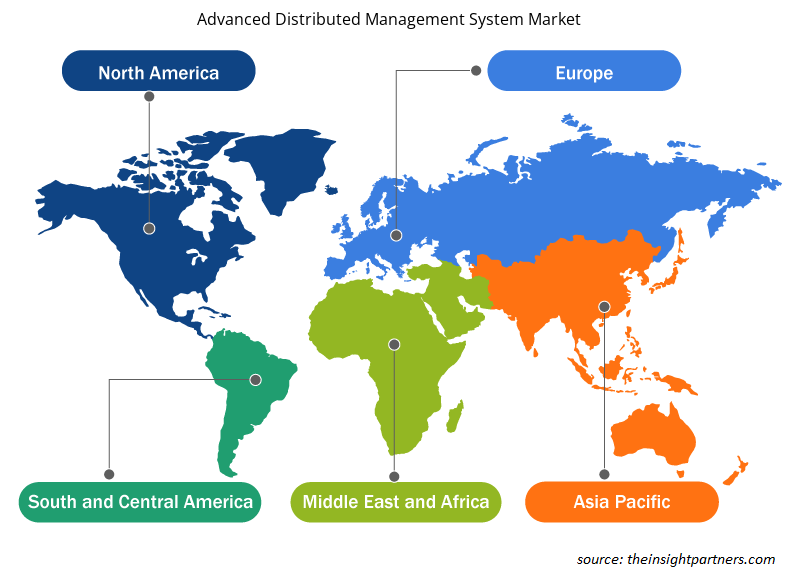高度分散管理システム市場規模は、2024年の33億2,000万米ドルから2031年には93億5,000万米ドルに達すると予測されています。市場は2025年から2031年にかけて16.6%の年平均成長率(CAGR)を記録すると予想されています。今後数年間、高度な分析、AI、機械学習の導入により、市場に新たなトレンドがもたらされる可能性があります。
高度分散管理システム市場分析
高度配電管理システム(ADMS)は、電力会社が配電網のパフォーマンスをリアルタイムで監視、管理、最適化できるようにする統合ソフトウェア プラットフォームです。再生可能エネルギー、電気自動車、分散型エネルギー リソース(DER)の統合や消費者需要の増加に伴い、電力網インフラストラクチャが急速に複雑化する中で、ADMS は現代のグリッド運用に不可欠なツールとなっています。ADMS は、配電網の運用を監視するための集中型プラットフォームを電力会社に提供し、停電管理、障害箇所の特定と分離、電圧最適化、負荷予測、リアルタイム ネットワーク モデリングなどの主要機能を備えています。サイロで動作する従来のシステムとは異なり、ADMS は監視制御およびデータ収集(SCADA)、配電管理システム(DMS)、停電管理システム(OMS)を統一されたインターフェイスに統合し、グリッド パフォーマンスの総合的なビューを提供します。
高度分散管理システム市場の概要
異常気象の発生頻度と深刻度の増加に加え、サイバー攻撃の脅威もエスカレートしており、電力会社は電力網の信頼性と回復力を強化する必要にかつてないほど迫られています。このようにリスクが変化する状況において、電力供給の中断を防ぎ、障害から迅速に回復することは、エネルギー供給業者、規制当局、そして利害関係者にとって戦略的な優先事項となっています。こうした課題への対応において、高度配電管理システム(ADMS)が極めて重要な役割を果たします。これらのプラットフォームは状況認識を強化し、事業者が電力網の状況をリアルタイムで監視し、異常を特定し、潜在的な障害に積極的に対応することを可能にします。統合された故障箇所特定、隔離、サービス復旧(FLISR)機能により、停電の自動検知、可能な場合の電力経路変更、そしてより効率的なサービス復旧が可能になり、電力会社は顧客のダウンタイムを最小限に抑え、経済的損失を軽減することができます。
このレポートの一部、国レベルの分析、Excelデータパックなど、あらゆるレポートを無料でカスタマイズできます。また、スタートアップや大学向けのお得なオファーや割引もご利用いただけます。
高度分散管理システム市場:戦略的洞察

-
このレポートの主要な市場動向を入手してください。この無料サンプルには、市場動向から見積もりや予測に至るまでのデータ分析が含まれます。
高度分散管理システム市場の推進要因と機会
グリッドの信頼性と回復力に対するニーズの高まり
「電気の未来のための信頼性の高い電力網」という調査によると、エネルギー消費の劇的な変化に伴い、米国の電力需要は近い将来大幅に増加すると予想されています。2025年3月には、データセンターのエネルギー使用量が300%増加すると予測され、eモビリティと電気自動車(EV)の充電に関連する需要は前例のない9,000%増加すると推定されています。その結果、最終エネルギー消費量全体に占める電力の割合は、2024年の21%から2050年には32%に増加すると予想されています。さらに、異常気象の頻度と深刻度の増加、そしてサイバー攻撃の脅威の高まりは、電力会社に対し、電力網の信頼性とレジリエンス(回復力)を強化するよう、かつてないほどのプレッシャーをかけています。その結果、途切れることのない電力供給と障害からの迅速な回復を確保することは、エネルギー供給業者、規制当局、そして利害関係者にとって戦略的な優先事項となっています。 ADMSソリューションは、自然災害やサイバーインシデントなど、様々なストレス下でも電力網の安定性を維持するために必要な、高度な分析、システムインテリジェンス、そして自動制御を提供します。ADMSプラットフォームは、高度な状況認識機能を提供することで、事業者が電力網の状況をリアルタイムで監視し、異常を特定し、潜在的な混乱に積極的に対応することを可能にします。統合された故障箇所特定、隔離、サービス復旧(FLISR)機能により、電力会社は停電を自動的に検知し、可能な場合は電力経路を変更し、より効率的にサービスを復旧できるため、顧客のダウンタイムを最小限に抑え、経済的損失を軽減できます。
さらに、電力系統のデジタル化と分散化が進むにつれ、停電への迅速な対応能力が運用効率を決定づけ、電力系統運用者にとって規制遵守と顧客満足度の確保に大きく貢献します。このように、電力系統の信頼性とレジリエンス(回復力)に対するニーズの高まりは、高度配電管理システム(ADMS)市場の成長を後押ししています。そのため、インフラの将来性確保、リスクの低減、そしてますます不安定化する環境下での事業継続性確保を目指す電力会社にとって、ADMSへの投資は戦略的に不可欠と認識されています。
再生可能エネルギー源の導入拡大
再生可能エネルギー源は、従来のエネルギー源を凌駕する勢いを増しています。これは、二酸化炭素排出量ゼロ、大気汚染と水質汚染の低減、経済的な電力生産といった要因によるものです。化石燃料、石炭、天然ガスの燃焼による炭素汚染の増加による地球温暖化の影響を受けて、再生可能エネルギー源の需要は徐々に増加しています。また、世界中の多くの政府が再生可能エネルギープロジェクトの導入に対して財政的インセンティブを提供しています。今後数年間で再生可能エネルギー発電プロジェクトが急増すれば、高度配電管理システム(ADMS)市場にビジネスチャンスが生まれると予想されます。ADMSは、配電用変電所で発電される電力の品質を測定するために不可欠です。
国際エネルギー機関(IEA)が述べたように、欧州連合はREPowerEU計画で概説されているように、2030年までにエネルギーミックスの再生可能エネルギーの割合を45%に増やす計画です。予想される増加は、1,236GWの再生可能エネルギー設備容量の必要性と、大陸全体でのクリーンエネルギー技術の展開の加速を反映し、ADMSソリューションの需要を促進すると考えられます。多くのヨーロッパ諸国が、長期的な気候目標とロシアのウクライナ侵攻後の差し迫ったエネルギー安全保障上の懸念の両方に駆り立てられて、再生可能エネルギー電力と暖房システムへの支援策を強化するにつれて、ますます複雑で分散化された電力網の安定性と効率性が最も重要になっています。さらに、クリーンエネルギー製造業を拡大するために2023年2月に開始されたグリーンディール産業計画は、EUの回復力のあるグリーンエネルギーインフラへの取り組みを強調しています。このように、世界中でエネルギー情勢が変化すると、変動、高調波、グリッド統合の課題を管理するために ADMS が必要になります。これにより、今後数年間で高度な配電管理システム市場に大きな成長の機会が生まれる可能性があります。
高度分散管理システム市場レポートのセグメンテーション分析
高度な分散管理システム市場分析の導出に貢献した主要なセグメントは、コンポーネント、グリッド タイプ、垂直です。
- 高度分散管理システム市場は、コンポーネント別にソリューションとサービスに分類されます。ソリューションセグメントは、2024年には市場シェアの拡大に貢献しました。
- 高度分散管理システム市場は、グリッドの種類別に、中電圧グリッド、高電圧グリッド、低電圧グリッドに分類されます。2024年には、中電圧グリッドセグメントが高度分散管理システム市場で最大のシェアを占めました。
- 高度分散管理システム市場は、垂直市場別に、公益事業、産業、商業に分類されます。2024年には公益事業分野が最大の市場シェアを占めました。
高度分散管理システムの地域別市場シェア分析
先進的分散管理システム市場レポートの地理的範囲は、主に北米、アジア太平洋、ヨーロッパ、中東およびアフリカ、南米および中米の5つの地域に分かれています。アジア太平洋地域は2024年に大きな市場シェアを占めました。アジア太平洋地域の先進的配電管理システム市場は、効率的で信頼性が高く持続可能なエネルギー配電ソリューションに対する需要の高まりに支えられ、力強い成長を遂げています。急速な都市化と工業化、再生可能エネルギー源の広範な統合などの主要な地域的傾向により、公益企業と政府は既存のグリッドインフラストラクチャを近代化し、先進的なグリッド管理技術に投資しています。より広範なエネルギー移行戦略の一環として、地方政府はエネルギーセキュリティを強化し、低炭素電力システムへの移行を支援するためにグリッドのアップグレードを優先しています。先進的メーターインフラストラクチャ(AMI)、需要応答システム、自動化ツールなどのスマートグリッド技術は、リアルタイムのグリッド監視、運用効率、および回復力を実現する主要な触媒として機能します。
高度分散管理システム市場の地域分析
Insight Partnersのアナリストは、予測期間を通じて高度分散管理システム市場に影響を与える地域的な動向と要因を詳細に解説しています。このセクションでは、北米、ヨーロッパ、アジア太平洋、中東・アフリカ、中南米における高度分散管理システム市場のセグメントと地域についても解説します。

- 高度分散管理システム市場の地域別データを入手
高度分散管理システム市場レポートの範囲
| レポート属性 | 詳細 |
|---|---|
| 2024年の市場規模 | 33億2000万米ドル |
| 2031年までの市場規模 | 93億5000万米ドル |
| 世界のCAGR(2025年~2031年) | 16.6% |
| 履歴データ | 2021-2023 |
| 予測期間 | 2025~2031年 |
| 対象セグメント |
タイプ別
|
| 対象地域と国 |
北米
|
| 市場リーダーと主要企業の概要 |
|
高度分散管理システム市場のプレーヤー密度:ビジネスダイナミクスへの影響を理解する
高度分散管理システム市場は、消費者の嗜好の変化、技術の進歩、製品メリットへの認知度の向上といった要因によるエンドユーザー需要の高まりに牽引され、急速に成長しています。需要が高まるにつれ、企業は製品ラインナップの拡充、消費者ニーズへの対応のための革新、そして新たなトレンドの活用を進めており、これが市場の成長をさらに加速させています。
市場プレーヤー密度とは、特定の市場または業界内で事業を展開する企業または会社の分布を指します。これは、特定の市場空間における競合企業(市場プレーヤー)の数が、その市場規模または市場価値全体と比較してどれだけ多いかを示します。
高度分散管理システム市場で事業を展開している主要企業は次のとおりです。
- シーメンスAG
- オラクル社
- シュナイダーエレクトリックSE
- ゼネラル・エレクトリック社
- キャップジェミニ
- エマーソン・エレクトリック社
免責事項:上記の企業は、特定の順序でランク付けされているわけではありません。

- 高度分散管理システム市場のトップキープレーヤーの概要を入手
高度分散管理システム市場のニュースと最近の動向
高度分散管理システム市場は、主要な企業出版物、協会データ、データベースなどを含む一次調査および二次調査に基づく定性・定量データの収集によって評価されます。市場における動向のいくつかを以下に示します。
- ADMSソフトウェアのリーディングプロバイダーであるSurvalentは、自動化ソリューション、電気材料、機器の地域サプライヤーである現地パートナーのElectrovalと共同で、コスタリカの連邦電力会社Instituto Costarricense de Electricidad(ICE)に最先端のADMSおよびDERMSソリューションを提供する入札を受注しました。この受注により、Survalentはコスタリカのエネルギー配電市場の75%を占めるADMSベンダーとなりました。(出典:Survalent Technology Corporation、プレスリリース、2023年4月)
- アスペンテクノロジー社は、オマハ公共電力局(OPPD)との戦略的パートナーシップを拡大し、2050年までにネットゼロカーボン生産という同社の目標達成を支援することを発表しました。アスペンテックは、OPPDの送電網における分散型エネルギー資源(DER)の監視、インテリジェントなスケジュール設定、制御を、ネブラスカ州5,000平方マイルに広がる88万5,000人の住民の信頼性維持のために、デジタルグリッドマネジメント(DGM)ソフトウェアスイートを提供します。(出典:アスペンテクノロジー社、プレスリリース、2024年8月)
高度分散管理システム市場レポートの対象範囲と成果物
「高度分散管理システム市場規模と予測(2021〜2031年)」レポートでは、以下の分野を網羅した市場の詳細な分析を提供しています。
- 高度な分散管理システムの市場規模と予測(対象範囲に含まれるすべての主要市場セグメントの世界、地域、国レベル)
- 高度な分散管理システム市場の動向、および推進要因、制約、主要な機会などの市場動向
- 詳細なPEST分析とSWOT分析
- 主要な市場動向、世界および地域の枠組み、主要プレーヤー、規制、最近の市場動向を網羅した高度な分散管理システム市場分析
- 市場集中、ヒートマップ分析、主要プレーヤー、および高度な分散管理システム市場の最近の動向を網羅した業界の展望と競争分析
- 詳細な企業プロフィール
- 過去2年間の分析、基準年、CAGRによる予測(7年間)
- PEST分析とSWOT分析
- 市場規模価値/数量 - 世界、地域、国
- 業界と競争環境
- Excel データセット
最新レポート
お客様の声
購入理由
- 情報に基づいた意思決定
- 市場動向の理解
- 競合分析
- 顧客インサイト
- 市場予測
- リスク軽減
- 戦略計画
- 投資の正当性
- 新興市場の特定
- マーケティング戦略の強化
- 業務効率の向上
- 規制動向への対応






















 無料サンプルを入手 - 高度分散管理システム市場
無料サンプルを入手 - 高度分散管理システム市場